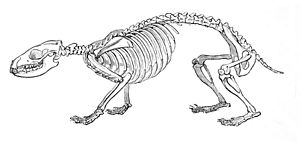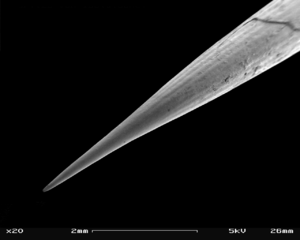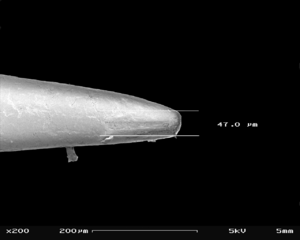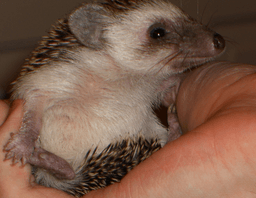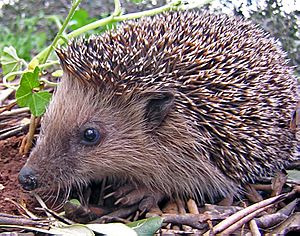Hedgehog facts for kids
Quick facts for kids Hedgehogs |
|
|---|---|
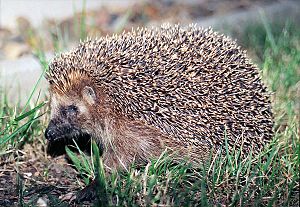 |
|
| European hedgehog | |
| Scientific classification | |
| Kingdom: | |
| Phylum: | |
| Class: | |
| Order: | |
| Family: | |
| Genera | |
|
|
- For the fictional character, see Sonic the Hedgehog
A hedgehog is a small mammal known for its spiky back. It is also sometimes called a hedgepig. When a hedgehog feels threatened, it can roll into a tight ball. This makes its sharp spines point outwards, protecting its soft belly.
Hedgehogs eat many different things. Their diet includes insects, snails, frogs, toads, and even small snakes. They also enjoy bird eggs, mushrooms, and berries. After a rainstorm, you might see them looking for earthworms.
Contents
What's in a Name?
The name hedgehog first appeared around the year 1450. It comes from two old English words: heyg (meaning "hedge") and hoge (meaning "hog"). They were called this because they often hide in hedgerows, and their snout looks a bit like a pig's. Other old names for them include urchin and furze-pig.
Where Do Hedgehogs Live?
There are seventeen different kinds of hedgehogs. They belong to five main groups, called genera. You can find them in parts of Europe, Asia, and Africa. They were also brought to New Zealand by people.
Hedgehogs live in many different places. These include deserts, forests, meadows, and grasslands. They can even live in people's backyards, especially if there are good hiding spots.
Physical Features
Hedgehogs are easy to spot because of their unique spines. These spines are actually hollow hairs that are made stiff with a material called keratin. Unlike the quills of a porcupine, hedgehog spines are not poisonous or barbed. They also do not easily fall out of their bodies.
When young hedgehogs grow, their baby spines fall out. These are replaced by adult spines. This process is called "quilling." Spines can also fall out if the animal is sick or very stressed.
A great defense for all hedgehogs is rolling into a tight ball. This makes all their spines point outwards. The hedgehog's back has two large muscles that control how the spines move. When rolled up, the spines protect their face, feet, and soft belly.
Some desert hedgehogs have fewer spines, so they are lighter. These hedgehogs might run away or even charge at an attacker. Rolling into a spiny ball is usually their last choice.
Hedgehog Behavior
Hedgehogs are mostly active at night. Some species might be active during the day too. During the day, hedgehogs usually sleep under bushes, in tall grasses, under rocks, or in dens they dig in the ground.
All wild hedgehogs can hibernate. This means they go into a deep sleep during cold weather. Not all of them do, though. It depends on the temperature, their species, and how much food is available.
Hedgehogs are quite vocal. They communicate using different sounds like grunts, snuffles, and squeals. The sounds they make can vary depending on the species.
Self-Anointing: A Strange Habit
Hedgehogs sometimes do a strange thing called anointing. When they find a new smell, they will lick and bite the source of the smell. Then, they make a foamy spit in their mouth. They use their tongue to spread this scented foam all over their spines.
No one is completely sure why hedgehogs do this. Some experts think it helps them blend in with the new smells around them. Others believe it might make their spines even more unpleasant for predators. This is because the foam could carry a bad taste or even germs.
What Do Hedgehogs Eat?
Hedgehogs are omnivores, meaning they eat both plants and animals. Their diet includes insects, snails, frogs, toads, and small snakes. They also eat bird eggs, dead animals (called carrion), mushrooms, grass roots, and berries. Some even eat melons and watermelons. For example, Afghan hedgehogs eat a lot of berries in early spring after they wake up from hibernation.
Who Hunts Hedgehogs?
Different hedgehog species have different predators. Forest hedgehogs are often hunted by birds, especially owls, and ferrets. Smaller species, like the long-eared hedgehog, can be prey for foxes, wolves, and mongooses.
In Britain, the main animal that hunts hedgehogs is the badger.
Reproduction and Life Cycle
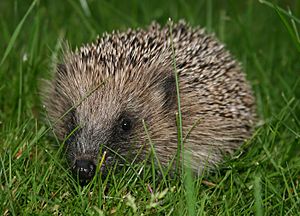
Hedgehogs live a relatively long time for their size. Larger hedgehog species can live 4 to 7 years in the wild. Some have even lived up to 16 years! Smaller species usually live 2 to 4 years in the wild, but can live 4 to 7 years if kept as pets. This is longer than a mouse (2 years) or a large rat (3-5 years). When hedgehogs are kept as pets, they often live longer (8-10 years) because they have no predators and a controlled diet.
A mother hedgehog usually has 3 to 4 babies for larger species, and 5 to 6 for smaller ones. Baby hedgehogs are born blind. Their quills are covered by a protective membrane. This membrane dries and shrinks in a few hours, allowing the quills to emerge.
Hedgehogs as Pets
The most common pet hedgehogs are a mix of the white-bellied hedgehog (also called the four-toed hedgehog) and the North African hedgehog. This pet hedgehog is smaller than the European hedgehog, so it is sometimes called the African pygmy hedgehog. Other species kept as pets include the long-eared hedgehog and the Indian long-eared hedgehog.
It is against the law to own a hedgehog as a pet in some places. This includes some US states like Hawaii, Georgia, Pennsylvania, and California. Some cities in Canada also have rules against them. In most European countries, there are no such restrictions, except in Scandinavia. In Italy, it is illegal to keep wild hedgehogs as pets.
Hedgehogs as Invasive Species
In some places where hedgehogs are not native, they have become a problem. For example, in New Zealand and the islands of Scotland, hedgehogs cause a lot of harm to local wildlife. They eat native insects, snails, lizards, and birds that nest on the ground. Since they were introduced, they do not have their natural predators in these new places.
It can be hard to remove them. Attempts to get rid of hedgehogs from bird colonies on the Scottish islands of North Uist and Benbecula caused a lot of international discussion.
Hedgehogs and Humans
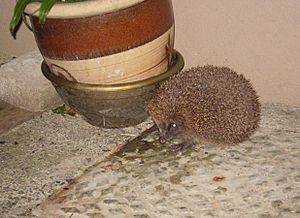
Like many small animals that live near people, cars are a big danger to hedgehogs. Many are hit by cars when they try to cross roads.
Hedgehogs in Culture
Hedgehogs have been a food source in many cultures throughout history. They were eaten in Ancient Egypt. Some old recipes from the Late Middle Ages even included hedgehog meat. In parts of Asia and Africa, hedgehogs are used in traditional medicine and for certain beliefs.
Hedgehogs also appear in many stories and popular culture:
- Sir Richard Onslow (1601–64), a politician, once compared King Charles I of England to a hedgehog.
- The main character in Beatrix Potter's 1905 children's story The Tale of Mrs. Tiggy-Winkle is a hedgehog.
- E. Nesbit wrote a fantasy short story called "The Princess and the Hedge-pig" (in The Magic World, 1912). In this story, a prince turns into a hedgehog because of a magical spell.
- Philip Larkin, a famous English poet, wrote a well-known poem about a hedgehog's death called "The Mower."
- Sonic the Hedgehog, first seen in 1991, is a fast blue hedgehog. He is the main character in many video games, comic books, and cartoons by Sega.
Cool Facts About Hedgehogs
- There are no hedgehogs that naturally live in Australia or the Americas.
- Hedgehogs have some natural protection against certain snake venom. This is due to a protein called erinacin in their muscles. However, a bite from a viper can still be deadly.
- When a hedgehog hibernates, its body temperature can drop to about 2 degrees Celsius (35.6 degrees Fahrenheit). When it wakes up, its body temperature rises back to its normal 30-35 degrees Celsius (86-95 degrees Fahrenheit).
- In 2006, McDonald's changed the design of their McFlurry containers. This was to make them safer for hedgehogs. Before, hedgehogs would get their heads stuck in the cups while trying to lick out leftover food. They would then starve because they couldn't get out.
- Pet hedgehogs sometimes get their heads stuck in tubes, like empty toilet paper rolls. They then walk around with the tube on their head! Owners call this "tubing." Many owners cut the tubes lengthwise to make sure the hedgehog can get out easily.
- In the Middle East, especially among Bedouins, hedgehog meat is believed to help cure problems like rheumatism and arthritis.
Images for kids
See also
 In Spanish: Erizo para niños
In Spanish: Erizo para niños


